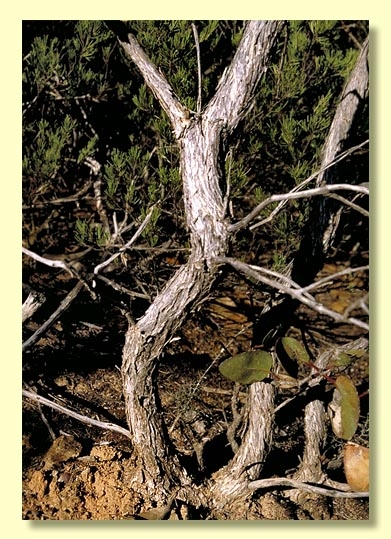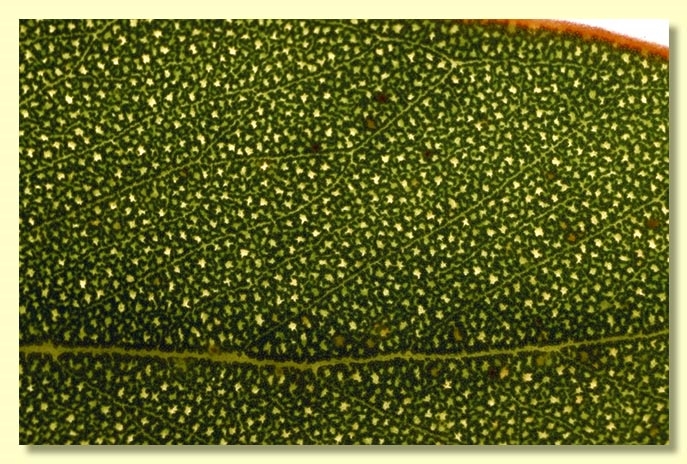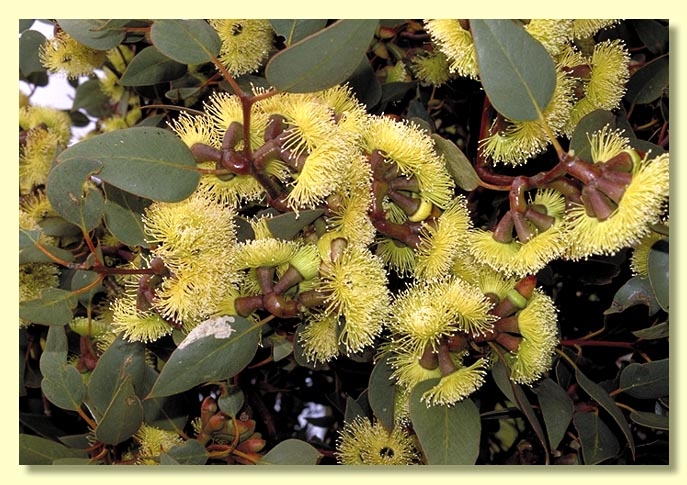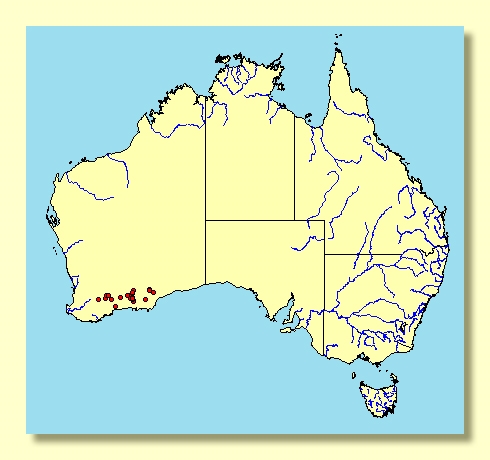Euclid - Online edition
Eucalyptus grossa
Eucalyptus | Symphyomyrtus | Bisectae | Glandulosae | Obliquae
Bark rough over whole trunks or only on the base of smaller stems, fibrous, slightly fissured, grey to grey-brown.
Branchlets with oil glands in the pith.
Juvenile growth (coppice or field seedlings to 50 cm): stems rounded in cross-section; juvenile leaves always petiolate, opposite for 1 or 2 nodes on coppice then alternate (but may revert to opposite throughout the life of the plant for few or many nodes), deltoid to ovate, 4.5–8 cm long, 3–5.5 cm wide, base truncate, rounded or tapering, green, becoming glossy.
Adult leaves alternate or opposite, petioles 1.5–4.5 cm long; blade ovate to broadly lanceolate, (6.5)7.5–12.5 cm long, 2.5–5.5(6.3) cm wide, base tapering to petiole or rounded, margin entire, apex pointed, green, glossy, thick, side-veins at an acute or wider angle to midrib, reticulation moderate to dense or obscure, intramarginal vein close to or remote from margin, oil glands irregular in shape.
Inflorescence axillary unbranched, peduncles stout and usually rigidly down-turned, 1–3.5 cm long, buds 7 per umbel, with short thick pedicels (pedicels 0–0.2 cm long). Mature buds buds 1.8–3.2 cm long, 0.7–1.3 cm wide, scar present, operculum conical, stamens mostly inflexed but some only terminally deflexed, anthers oblong, versatile, dorsifixed, dehiscing by longitudinal slits, style long and straight, stigma blunt, locules (3)4 or 5, the placentae each with 8 vertical rows of ovules. Flowers yellow-green.
Fruit sessile or shortly pedicellate (pedicels 0–0.2 cm long), long-cupular to cylindrical, 1.4–2 cm long, 1–1.5 cm wide, disc vertically descending, valves (3)4 or 5, at rim level or enclosed.
Seeds dark brown to greyish brown, glossy, 1–1.5 mm long, cuboid to angular-ovoid or flattened-ovoid, dorsal surface virtually smooth, hilum terminal or ventral.
Cultivated seedlings (measured at ca node 10): cotyledons Y-shaped (bisected); stems rounded in cross-section; leaves with thick petioles, opposite for 4 to 6 nodes then alternate, ovate, 7–8.5 cm long, 3.5–5 cm wide, green, dull at first but glossy by ca node 5.
Flowering has been recorded in June, August and September.
A straggly low mallee or shrub endemic to Western Australia, from the south-eastern wheatbelt to the southern goldfields, east from Newdegate to Clyde Rock and almost to Balladonia. The bark is rough on the stems and larger branches, and the adult leaves are very thick, glossy, green to yellow-green, and the buds are large, down-turned and have yellowish green stamens.
Eucalyptus grossa belongs to Eucalyptus subgenus Symphyomyrtus section Bisectae subsection Glandulosae because the cotyledons are bisected, buds have an operculum scar and the branchlets have oil glands in the pith. Within this subsection (of ca 80 species), however, E. grossa is not closely related to any particular species, forming the monotypic series Obliquae, because of its unusual habit, leaf, floral and seed features. It has rigidly deflexed bud clusters, large buds and flowers, and the seeds are angular-ovoid with a smooth surface. It is unlikely to be confused with any other eucalypt.
E. grossa is sometimes cultivated for its shrubby habit, glossy large leaves and yellow-green flowers.















